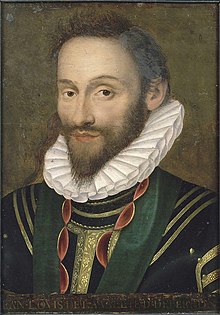Château Branaire-Ducru
The Château Branaire is a known vineyard of Bordeaux . Since the classification of 1855 , the winery has been classified as "Quatrième Grand Cru Classé ", ie in the fourth level of the classification.
It is located in Saint-Julien-Beychevelle , directly opposite the magnificent neighbor Château Beychevelle . The estate is medium-sized with around 50 hectares . 74% of the area is with the grape Cabernet Sauvignon , 22% with Merlot and 4% with Petit Verdot planted. The mean age of the vines is 40 years (as of 2006). The estate produces around 180,000 bottles of its Grand Vin in the middle years .
Among the Branaire-Ducru vintages, the red wines of 2005 (95 PP Parker points ), 2003 (95 PP), 2001 (89–91 PP), 2000 (95 PP), 1996 (91 PP) and 1995 (90 PP ).
The second wine of the winery is called Duluc de Branaire-Ducru . In normal years, around 84,000 bottles are filled with this wine .
Château Branaire-Ducru is accompanied and advised by the oenologist Jacques Boissenot and his son Eric.
history
The early history of the estate is identical to that of Château Beychevelle; the land was originally part of the Seigneurie de Lamarque. Beychevelle land has been cultivated since at least the early 14th century. In the late 14th century, a facility with a fortified donjon was built near the Gironde in order to be able to defend the estuary against attacks in the “ Hundred Years War ”. At the end of the 14th century the property belonged to Archambaud de Grailly . Archambaud married Isabelle de Foix in 1381 , so that the property passed from the House of Grailly to the House of Foix-Candale as part of the distribution of the estate .
When Jean Louis de Nogaret de La Valette married Marguerite de Foix-Candale, the sole heir to the estate in 1587, the estate known as Château de Médoc passed into the possession of the Dukes of Épernon. Jean Louis de Nogaret de La Valette was considered one of the most powerful men in France in his time.
Jean Louis' son Bernard de Nogaret de La Valette , like his father, showed little interest in the property, and when he died on July 25, 1661, he left behind a large mountain of debt. To pay off the debts, Beychevelle briefly went to the royal family and was eventually sold to the Abbadie family. Under the direction of the Abbadie family, the property was split up from Beychevelle and in 1680 Jean-Baptiste Braneyre bought part of what is now known as Branaire-Ducru.
Jean-Baptiste's daughter Marie married Pierre du Luc, so that the property passed into the du Luc family. Her son Laurent du Luc, born in 1730, later inherited the estate. Laurent married Marie de Chillaud des Fieux de Larenchère, daughter of an officer, in 1779. Despite their aristocratic background, Laurent and Marie survived the French Revolution and were even able to keep their property despite a prison sentence. By changing the name du Luc to Duluc , they distracted from aristocratic descent. The winery's first heyday fell in the time of Laurent.
When Laurent died in 1814, his wife Marie ran the estate for another four years and bought even smaller plots near the hamlet of Bourdieu. After their death, the sons Louis and Justin Duluc inherited the estate and expanded it. In 1824 they built the manor house known today and named the property Château Braneyre and finally Château Branaire.
In 1855, on the occasion of the World Exhibition in Paris, the estate was included in the official classification of Bordeaux.
When Louis Duluc died childless just a year later, the property was run by his widow, brother and nephew. The very complicated ownership structure was not simplified until 1875, when Chateau Branaire belonged only to Gustave Duluc and his sister Zélie Ravez. Gustave bought his sister's share, but died in 1879, four years later. The property that Gustave had united passed back to his sister. After her death in 1899, her nephews inherited the Marquis de Carbonnier de Marzac, the Comte de Ravez and the Comte du Périer de Larsan. The three crowns on the label of the wine bottles symbolize the situation at that time.
Due to a lack of interest, the estate was sold to Jean-Michel Tapie in 1919. Overall, the Tapie era was not very happy, and the quality of the wines produced was no longer in relation to the classification.
In 1988 the Maroteaux family took over the estate and Patrick Maroteaux took over as managing director. He hired Philippe Dhalluin as technical director.
Web links
literature
- Charles Cocks, Edouard Féret, Bruno Boidron: Bordeaux et ses vins . 18th edition. Èdition Féret et Fils, Bordeaux 2007, ISBN 978-2-35156-013-6 .
- Horst Dippel : The wine lexicon . 3. Edition. Fischer Taschenbuch Verlag, Frankfurt am Main 1999, ISBN 3-596-13826-4 .
- Robert Parker : Parker's Wine Guide (= Collection Rolf Heyne ). Heyne, Munich 2000, ISBN 3-453-16305-2 .

